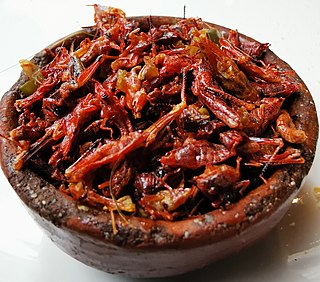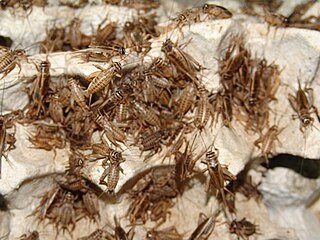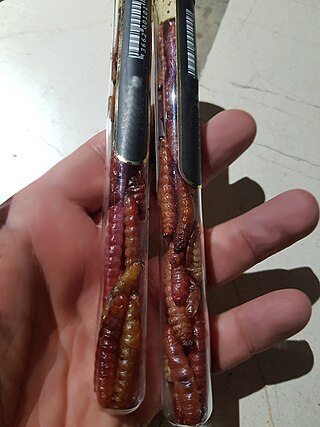
Entomophagy in humans or human entomophagy describes the consumption of insects (entomophagy) by humans in a cultural and biological context. The scientific term used in anthropology, cultural studies, biology and medicine is anthropo-entomophagy. Anthropo-entomophagy does not include the eating of arthropods other than insects such as arachnids and myriapods, which is defined as arachnophagy.

Gonimbrasia belina is a species of emperor moth which is native to the warmer parts of southern Africa. Its large edible caterpillar, known as the mopane worm, madora, amacimbi “pigeon moth”, masonja or Seboko sa Mongana, feeds primarily but not exclusively on mopane tree leaves. Mophane worms are an important source of protein for many in the region. The species was first scientifically described by John O. Westwood in 1849.

Chapulines, plural for chapulín, are grasshoppers of the genus Sphenarium that are commonly eaten in certain areas of Mexico. The term is specific to Mexico and Central America, and derives from the Nahuatl word chapolin (singular) or chapolimeh (plural).
Economic entomology is a field of entomology, which involves the study of insects that benefit or harm humans, domestic animals, and crops. Insects that pose disadvantages are considered pests. Some species can cause indirect damage by spreading diseases, and these are termed as disease vectors. Those that are beneficial include those that are reared for food such as honey, substances such as lac or pigments, and for their role in pollinating crops and controlling pests.

Lethocerus indicus is a giant water bug in the family Belostomatidae, native to South and Southeast Asia, as well as southeast China, the Ryukyu Islands, and New Guinea. It was originally described as Belostoma indicum but is no longer placed in that genus.
Jumiles are small stink bugs native to the Taxco region of the state of Guerrero in Mexico. Their diet includes the leaves of the encina tree. Chumiles are a smaller, similar stink bug of the same region. Any edible Hemiptera from the families Coreidae or Pentatomidae may be considered jumiles as well.

Escamoles, known colloquially as Mexican caviar or insect caviar, are the edible larvae and pupae of ants of the species Liometopum apiculatum and L. occidentale var. luctuosum. They are most commonly consumed in Mexico City and surrounding areas. Escamoles have been consumed in Mexico since the age of the Aztecs. The taste is described as buttery and nutty, with a texture akin to that of cottage cheese.

Chahuis or xamoes are the common names given in Mexico to a variety of edible insects within the insect order Coleoptera (beetles).

A mezcal worm is an insect larva found in some types of mezcal produced in Oaxaca, Mexico. The larva is a red maguey worm, the caterpillar of the Comadia redtenbacheri moth, usually called chinicuil or gusano rojo. The red worm is typically considered tastier than a white maguey worm.

Nsenene is the Luganda name for Ruspolia differens: a bush cricket in the tribe Copiphorini of the 'cone-head' subfamily. It is often confused with the closely related Ruspolia nitidula.

Insect farming is the practice of raising and breeding insects as livestock, also referred to as minilivestock or micro stock. Insects may be farmed for the commodities they produce, or for them themselves; to be used as food, as feed, as a dye, and otherwise.

Atta mexicana is a species of leaf-cutter ant, a New World ant of the subfamily Myrmicinae of the genus Atta. This species is from one of the two genera of advanced attines within the tribe Attini.

Insects as food or edible insects are insect species used for human consumption. Over 2 billion people are estimated to eat insects on a daily basis. Globally, more than 2,000 insect species are considered edible, though far fewer are discussed for industrialized mass production and regionally authorized for use in food. Many insects are highly nutritious, though nutritional content depends on species and other factors such as diet and age. Insects offer a wide variety of flavors and are commonly consumed whole or pulverized for use in dishes and processed food products such as burger patties, pasta, or snacks. Like other foods, there can be risks associated with consuming insects, such as allergic reactions. As commercial interest in insects as food grows, countries are introducing new regulatory frameworks to oversee their production, processing, marketing, and consumption.

Gynanisa maja, the speckled emperor or chipumi, is a moth of the family Saturniidae. The species was first described by Johann Christoph Friedrich Klug in 1836. It is known from South Africa to eastern Africa. Gynanisa nigra is just a darker form and not a distinct species.
Insect-based pet food is pet food consisting of, or containing insects digestible by pets such as dogs or cats. A limited, but growing number of products are available on the market, including insect-based cat food, dog food, and pet treats.

Maguey worms are either of two species of edible caterpillars that infest maguey plants.
Arachnophagy describes a feeding behaviour that includes arachnids. Aside from non-human creatures, the term can also refer to the practice of eating arachnids among humans.

Entomophagy is the practice of eating insects. An alternative term is insectivory. Terms for organisms that practice entomophagy are entomophage and insectivore.
Catatos is a traditional Angolan dish made with fried caterpillars and garlic. It is often served over rice. The dish is a specialty of the Uíge Province in northwestern Angola.














